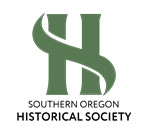In 1900, Cinnabar Springs was a successful California resort accessible only by horseback over a narrow trail, either from the Applegate area on the Oregon side or from the Klamath River on the California side.
Families could camp or stay in the two-story log hotel and choose between a salt spring to cure stomach troubles or headaches and a sulphur spring for rheumatism. Healthy family members played croquet, horseshoes and went dancing on Saturday night. Everyone at least tried drinking the effervescent water, some even competing to see who could hold down the most. The man who discovered the springs, a bear hunter named Walker, insisted the mineral waters saved his life. He said he was nearly dead when he camped near the spring for a winter and miraculously recovered. Another man who had faith in Walker’s claim, Jobe Garretson, secured property rights and built the first hotel. Garretson died at 91, convinced the waters had given him long life. Even a wagon road, built in 1905, could not keep people coming to Cinnabar Springs forever. By the 1930s people depended on physicians rather than healing waters, and no doubt preferred to visit resorts on paved highways.
Sources: Lewis, Raymond, “Cinnabar & Colestin… Revisited”, Table Rock Sentinel, v. 6, no. 5, May 1986, p. 22; Williams, Evelyn Byrne, “Cure-alls at Cinnabar Springs”, Applegater, Fall 2009. http://www.applegater.org/pdf/2009/v02n04/v02n04p21.pdf
The SOHS Library is OPEN to the public at 106 N. Central Avenue in Medford, with FREE access to the SOHS Archives, from 12:00 - 4:00 pm, Tuesday through Saturday. Appointments are not necessary. Please contact library@sohs.org, or call 541-622-2025 ex 200 to ask questions or request research.
Families Camp at Remote Cinnabar Mineral Springs
Episode
2487
Date
